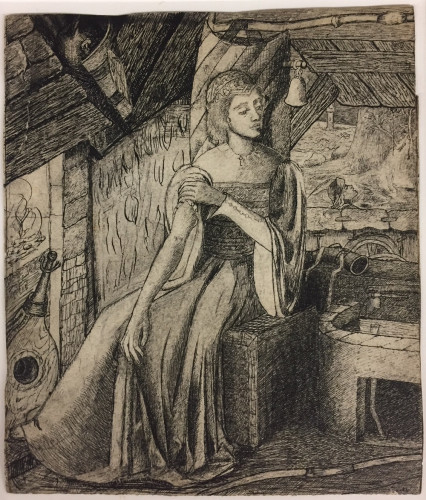Edward Burne-Jones had no formal art training and the rather awkward perspective and drawing of the figure in this work suggests it was drawn at an early date. The cross-hatching for the modelling figure, shadows and shading suggests the drawing was made for an illustration, possibly Cupid’s daughter by his forge from Geoffrey Chaucer’s poem The Parlement of Fowles:
Under a tree, besyde a welle, I say
Cupyde our lord his arwes forge and fyle;
And at his fete his bowe al redy lay,
And wel his doghter tempred al this whyle
The hedes in the welle, and with hir wyle
She couched hem after as they shulde serve,
Some for to slee, and some to wounde and kerve
This drawing was possibly reused in Burne-Jones watercolour ‘Cupid’s Forge’ (1861) now in a Private Collection.
Previous attempts to identify the drawing by Waters & Harrison suggested that the subject shown is ‘an Arthurian incident, possibly the Lady of Shalott’. However, there is no loom, no mirror, no river and the figure of the man beyond the open window, though singing, hardly resembles ‘the bold Sir Lancelot’ of Tennyson’s poem ‘The Lady of Shalott’. A later alternative suggested it was from ‘King Grisly-Beard’ in Grimm’s ‘Fairy Tales’, a source of inspiration for other works by Morris and Burne-Jones at this early date. This story tells of a king’s daughter who spurns so many suitors that her father makes her marry the first beggar who comes to the palace. He turns out to be a strolling musician (King Grisly-Beard, one of the rejected suitors in disguise) who takes her to live in a cottage in a forest where she is made to cook and do other menial tasks.

